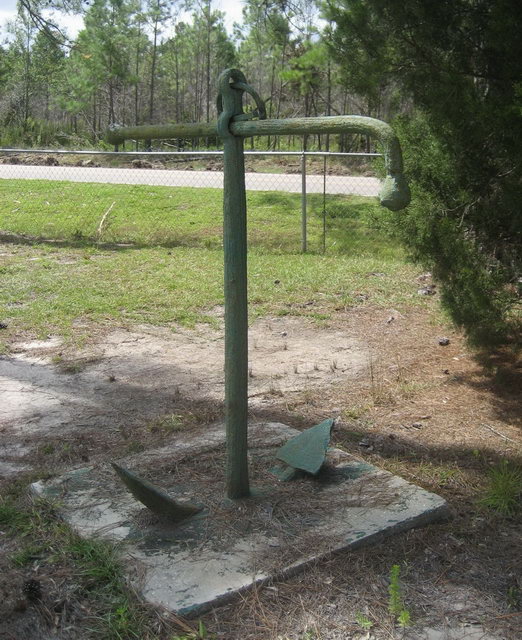An Admiralty Anchor
…a Gift to HCHS
 A gift from "Poss" La France
A gift from "Poss" La France
Recent visitors to the Lobrano House may have noticed a new presence in our garden. It is a six-foot high, cast iron anchor of the “admiralty” type. It probably weighs several hundred pounds, and indeed it took a wrecker to pick it up and deliver it to us. Soon, it will take its logical place next to the Pass Marianne light which already graces our little garden.
Credit for the donation of this large artifact from our past goes to Jules “Poss” LaFrance. He was the subject of an interview done three years ago for the Historian, at the suggestion of County Clerk Tim Kellar. Tim knew that Poss had many stories to tell, as he was then 91-years old and had spent most of his adult life in the marshes around Ansley, shrimping, catching bait and managing his LaFrance Marina. Of course, he weathered a few hurricanes in between.
Poss is now “pushing 94.” He is as tall and straight as he was at the time of that interview. In spite of Katrina’s surge having flooded the area, he is now back in his rebuilt home on Lower Bay Road.
In the 2004 interview, he told the story of the anchor. Back in the ‘60’s, sometime after he had bought his Biloxi schooner, the Mabel L, Poss was aware that shrimpers would catch – and sometimes lose – their nets on something in the Pearl River, west of the railroad bridge. One time, while catching bait, it happened to Poss. He pulled and pulled and would back up to the obstacle until he nearly flooded the deck of the Mabel L. Presently, another shrimper observed the problem and offered help. Together, they pulled, and after making small headway, the anchor finally gave up to the Mabel L’s winch.
No one knows how long that anchor had been on the bottom. Poss knew that at one time, before his time, there had been an old oyster factory nearby. On the bank, he remembers, there had been the remnant of an old schooner. It had been a derelict a long time, finally consumed by repeated marsh fires over the years. Poss theorizes that the anchor might have come from it, but whatever boat had used that anchor had to have been a good size.
Poss had mentioned in 2004 that he desired to give his anchor to a museum, and had in fact offered it to one of the maritime museums in a neighboring county. Knowing that it had not yet been claimed by the time of Katrina, and that the museum no longer existed, this writer, as a representative of HCHS, visited Poss.
I reviewed with Poss that the museum he had mentioned had not come for the anchor. I then said, “Poss, this is a Hancock County anchor.” At that point, he immediately extended his hand and said, “It’s yours.”
True to his heritage, that’s the way things were done in Poss’s time.
From there, it was a matter of contacting a wrecker service. One call to Danny Page, the new owner of the Mike Perniciaro shop, was all that was needed. Danny agreed to pick it up the next day. Graciously, he did not charge HCHS.
Research shows that admiralty anchors were first used by the British navy from about 1831. They continued in use, with a few modifications, until about 1860. If anyone can add to our knowledge of the use of this type and size in our waters, please contact this writer, Charles, or Eddie.